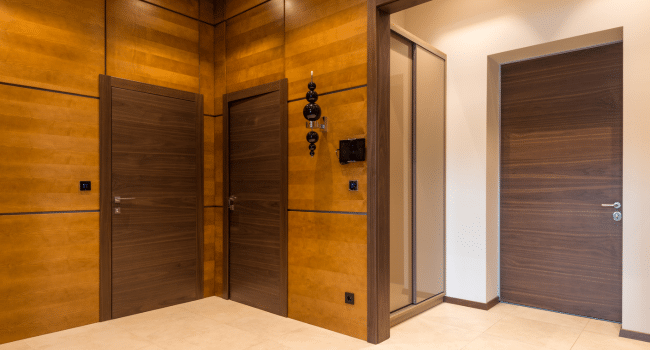Table of Contents
When it comes to home design, internal doors are often treated as an afterthought. Yet, they play a surprisingly important role in both functionality and style. The right internal door not only provides privacy and insulation but also complements the overall aesthetic of your living space.
If you’re planning to upgrade your home or replace old doors, this guide covers everything from choosing materials to understanding standard sizes and installation considerations.
Why Internal Doors Deserve More Attention
Most people think of paint colours and furniture when updating a home’s interior, but the type of door between rooms can significantly impact the feel of a space.
For example, heavier solid wood doors offer a sense of privacy and luxury, while lighter glazed doors can make smaller areas feel brighter and more open. Choosing the right internal doors involves balancing form and function.
1. Choosing the Right Material for Your Space
One of the first decisions you’ll face is choosing the door material. Each type comes with its own benefits and drawbacks:
- Solid Wood
Solid wood doors are durable, long-lasting, and excellent at reducing sound transfer between rooms. They tend to be more expensive but offer a premium finish and feel. - Engineered Wood (MDF or Composite)
These doors are typically made from a core of medium-density fibreboard (MDF) or other engineered wood products, covered with a veneer or laminate. They’re budget-friendly, stable, and less likely to warp or crack over time compared to solid wood. - Glazed Internal Doors
Perfect for areas where you want to maintain light flow between rooms—such as a living room and kitchen—glazed doors feature glass panels set into wooden or composite frames.
If you’re exploring different finishes, configurations, or styles, browsing a curated range of internal doors can help clarify what works best for your layout and lifestyle.
2. Selecting a Style That Suits Your Interior
Once material and size are sorted, the next decision is style. Your choice here can dramatically influence the feel of a room:
- Panelled Doors
These feature raised or inset panels and work well in traditional homes. They’re available in various layouts, from two to six panels. - Flush Doors
Minimalist and sleek, flush doors have a flat surface with no detailing. They fit modern and contemporary interiors beautifully. - Sliding or Barn Style Doors
A great solution for saving space or adding a rustic touch. Sliding doors are often used for closets, pantries, or open-plan room dividers.
3. Understanding Standard Internal Door Sizes
A common pitfall for first-time buyers is overlooking the importance of accurate measurements. Doors aren’t always a one-size-fits-all solution. In the UK, there are typical measurements most suppliers use, but it’s always worth checking before you buy.
According to standard internal door size UK guidelines, popular sizes include:
- 1981 mm x 762 mm (6’6” x 2’6”)
This is often referred to as the ‘standard’ size for residential properties. - 2040 mm x 826 mm
Seen more in modern homes with taller ceilings and wider doorways.
Some older properties may have non-standard frame sizes, requiring custom-made or trimmed doors. Measuring both the width and height of the existing frame (as well as the door thickness) is essential before placing an order.
4. Don’t Overlook Installation Essentials
A perfectly chosen door is only as good as its installation. Poorly fitted doors can stick, rattle, or leave gaps that compromise privacy and insulation. Here are key things to keep in mind:
- Allow for Clearance
Doors often need a gap at the bottom for ventilation, especially in rooms like bathrooms and kitchens. - Check for Trimmable Edges
Some engineered doors have a limit on how much you can trim without affecting their structure. Be sure to confirm this with the supplier. - Hardware Compatibility
Choose handles, locks, and hinges that match both the style and thickness of your door. Pre-drilled options can save time during fitting.
If DIY isn’t your thing, hiring a professional door fitter ensures everything aligns perfectly—especially for more complex installations like sliding tracks or glazed panels.
When considering style and functionality together, many homeowners opt for hidden barn door hardware to achieve a clean, modern look. This option not only saves space but also adds a sleek and seamless finish to any internal door, blending practicality with aesthetic appeal.
5. Balancing Quality, Budget, and Longevity
Internal doors are a long-term investment, so it’s worth balancing cost with quality. Cheaper hollow-core options might save money upfront but often lack the sound insulation and durability of solid or engineered wood doors.
Think about which areas of your home see the most traffic and where spending a little more might pay off in the long run. Bedrooms, bathrooms, and living spaces generally benefit from higher-quality doors, while lesser-used rooms like storage areas might not require the same standard.
Make Smart Door Choices That Elevate Your Home
Selecting internal doors may seem like a small detail, but it genuinely impacts your home’s look, feel, and functionality. From choosing materials and styles to understanding standard sizes and installation factors, taking a thoughtful approach ensures the result is both practical and visually appealing.
Whether you’re refreshing a single room or undertaking a full renovation, planning your internal door choices carefully will help tie your entire interior together.
